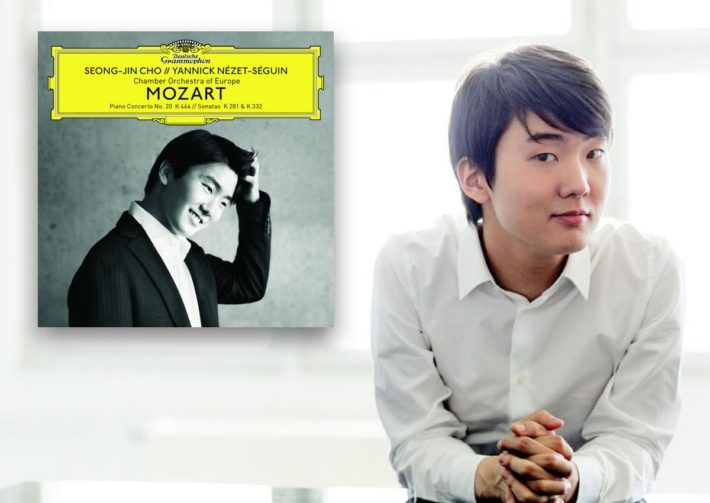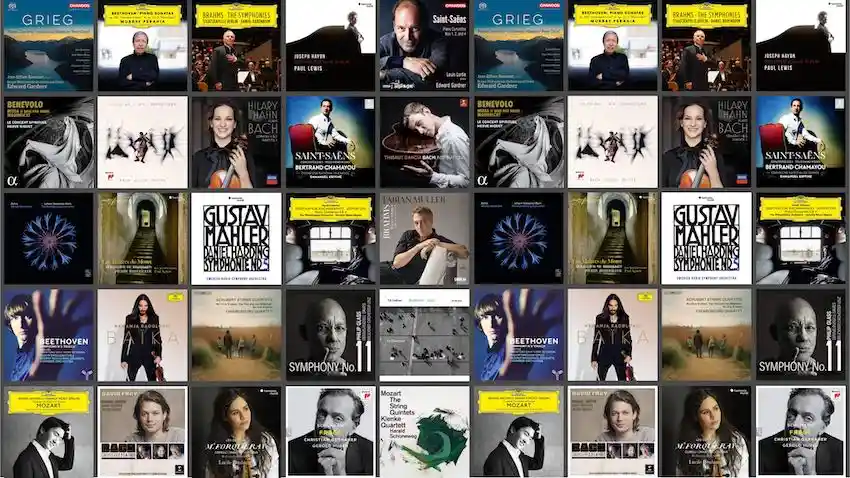What is it with great Chopin players, that they seem to be so talented in so many other music periods, moving between them as naturally as a musical chameleon?
Seong-Jin Cho (조성진) , winner of the 2015 Chopin Competition, has already produced successful albums with music by Chopin and Debussy. Now he turns his attention to Mozart, giving a persuasive account of the dark D Minor Piano Concerto and two Solo Sonatas.
This is the second album covered in these pages where Yannick Nézet-Séguin accompanies a star pianist, the first being the highly enjoyable release of Daniil Trifonov’s playing Rachmaninov’s Piano Concertos No. 2 & 4. Nézet-Séguin provides a dedicated support here as well, giving the Chamber Orchestra of Europe a Mozartian flair he so successfully projected in his Mozart’s Opera series with the same ensemble. Piotr Anderszewski, in his latest release with the same orchestra (and different pieces), chose to remain conductorless, a choice that should be questioned based on the much better accompaniment we have here.
The first bars set the scene for a dramatic, sometimes tumultuous account. The Mozart concertos are tricky to pull off, especially since they are more of chamber works than what was known later as a bravura-centered “soloist concerto”. Cho and Nézet-Séguin work hand-in-hand in these chamber-like movements – Hear how wonderfull Cho’s playing is in the second subject appearance (3:45) and later on in his dialogue with the woodwind section. The stormy middle episode in the second movement is painfully felt, with oboe, flute and bassoon give their best.
Cho’s Mozart is of a pianist that feels at home with this repertoire, no less than he sounded on his latest (and superb) Debussy album nor, of course, his Chopin recordings. His dynamic range, Forte never bombastic but projected as the peak level of the instrument, is wholly appropriate, as do the small added ornaments and improvisations to the written text – The second movement repeated phrases is a good example, or the unexpected small cadenza-like stop at the third movement (2:23).
Get periodic updates about new classical music albums reviews, news and guides.
We respect your privacy.
It’s worth mentioning how well Cho plays the Beethoven Cadenzas in the two outer movements. It makes one wants to hear more solo Beethoven from this artist.
To sum up the Concerto, we have here a persuasive, consistently played account by all parties involved, that can be enjoyed along with some other digital chamber orchestra versions, like Andsnes with the Norwegian Chamber Orchestra, Goode with the Orpheus Orchestra and Pires with Orchestra Mozart under Abbado, which we reviewed here. Cho is at the most dramatic, energetic scale of things, but not less successful.
Solo Mozart
As it happens, Cho chose two of Mozart’s most meticulously annotated Solo Piano Sonatas to add to the Concerto, and he duly observes them all without sounding one bit studied. The second movement of K.281 sings unashamedly without scarifying a single direction by the composer, be it phrasing, dynamics, shortening of notes and ornaments. But that’s of course only part of the spirit of any piece of music. Cho brings life to this movement and the rest of the sonata with playfulness, emotional involvement and a true wonder from the piece. K.281 3rd movement is a good example – Hear how the sunny mood turns surprisingly dark in 1:15, and then how almost imperceptibly cho clears the skies, so to speak, to the return of the main theme. In his complete survey, William Youn gave a fascinating account of this Sonata, and although not as coherently persuasive, Cho’s version will be preferable to many who want more warmth and a hint of romanticism in their solo Mozart.
K.332 that closes the album seals the impression of Cho as an original and well immersed Mozart player, even though I felt this one less memorable than k.281. It’s very nicely handled, but sometimes over-peddled and the third movement is too fast even for an “Assai Allegro”. Here again, the slow movement stands out as the peek of the performance.
Cho’s style in the solo works can perhaps be compared to the young Barenboim EMI version of the solo piano works than other “Mozart specialists” such as, say, Uchida’s sometimes too cautious version or the more recent delicate and understated Christian Blackshaw’s complete cycle from Wigmore Hall. Indeed, from all recent complete cycles of the solo Piano Sonatas, Wiliam Youn stands out. Cho gladly brings his own voice to Mozart and so this is a highly enjoyable album.
(Images: ©️ Harald Hoffmann / DG)

Mozart – Piano Concerto No. 20 in D Minor, K. 466, Piano Sonatas K. 281, k.332
Seong-Jin Cho – Piano
Chamber Orchestra of Europe
Yannick Nézet-Séguin – Conductor
Deutsche Grammophon, CD 0289 483 5522 8
Follow Us and Comment:
Get our periodic classical music newsletter with our recent reviews, news and beginners guides.
We respect your privacy.










